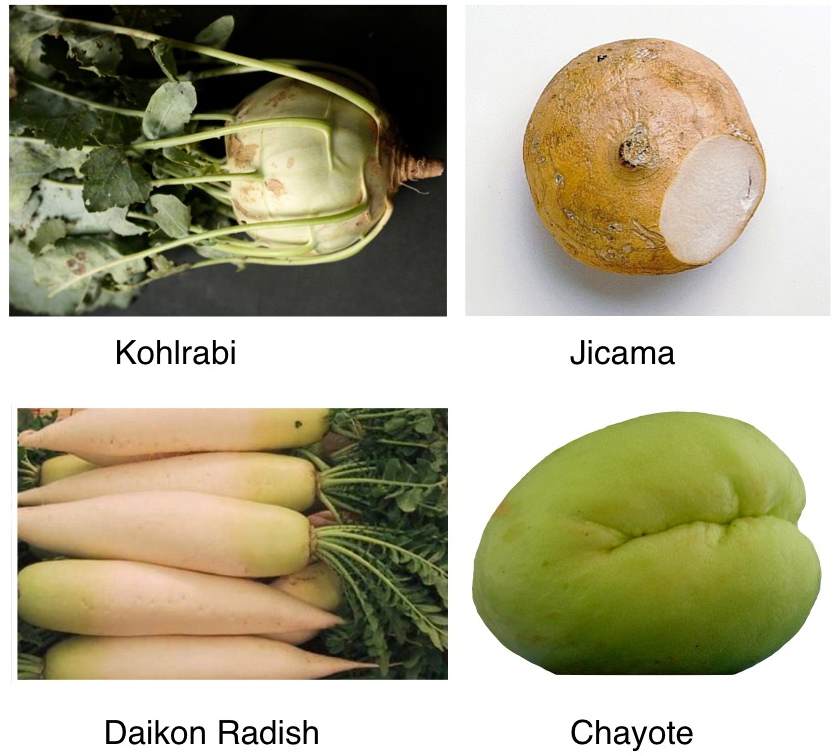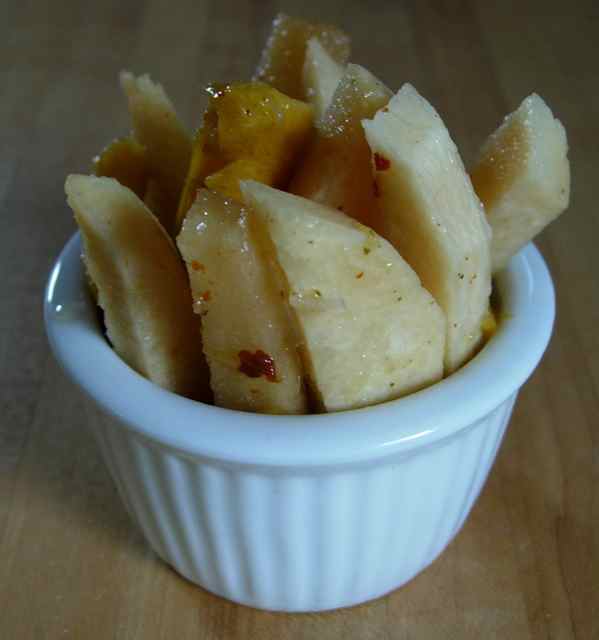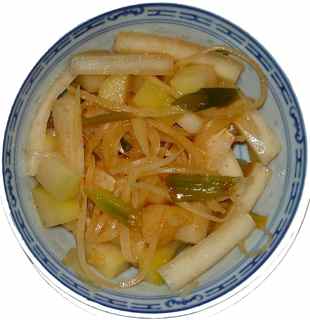Brine Pickling Monthly
The Science in Homemade
by Bill Hettig, Master Brine Pickler
This Issue
• Budding New Pickling Stars
• New Recipe: Rogan Josh Cubes & Spears (Northern India)
• Why We are Brine Picklers
• The Nose Knows
Budding New Pickling Stars
Let’s take an expedition to the green grocer’s exotic section -- Come on! I am so excited to introduce you to my new pickling mates.

In a few short minutes you are going to be up to your elbows in new pickling journeys. I am going to show you a fabulous pickle recipe from Northern India that can be used as a meal-maker’s power tool.... Add it to any variety of cooked starch side dishes to make it bolder, make it bigger. This is a new world of old world pickling.
Debuting the Fabulous Four....... (drum roll, please)
1 Kohlrabi- Is a member of the cruciferous family and a direct relative of broccoli. It looks oddly like the Sputnik satellite—globular with antennae. Once peeled, you have crunchy, moist broccoli flavor. At farmers markets they can get as big as softballs, and are (mistakenly) marked down for being too big. Not for pickling. You don’t need to do much in flavoring—just brine and maybe a spice blend—curry or blackening is fine. One of my favorite blends is “Corned Beef Spice Blend” by Penzeys (penzeys.com). Vegan and meaty ... and made in minutes.
2 Jicama- [HEE-ka-ma] escaped my childhood, teenage, and early adult lives; not any longer. Its roots are in Meso-America and has a sweet, apple-like crunch. It stays crisp in brine forever. Just a quick peel and chop and you’re entering Emerald City. This is my workhorse in the test kitchen. It’s like a mild fruit, it shreds beautifully, chops into any number of shapes, stays crunchy, is snow white and is versatile in being the backbone to any number of pickling recipes.
3 Chayote- [Chay-OAT-tay] - Also known as mirliton in the South, and Mexican or pear squash, is a pickler’s dream—easy to peel, seed, and make into shapes. Its exotically jade in color, has a creamier texture than jicama, and stays firm as a pickle. It has a subtle green glow in brine. Magnifique!!
A favorite recipe of mine— Pico de Gallo (1 qt.): Combine 1 pound total using some  or all of these budding stars: kohlrabi, jicama, and chayote. Shape into spears. Prepare a standard brine mixed with 2 tsp. ancho chile powder or Korean chile flakes, and 2 tsp. lime zest. After fermentation, serve with a squeeze of lime juice. This makes a great hot weather snack. A version of this is served in Mexico City as “Pico de Gallo” (not the salsa staple of N. Mexico).
or all of these budding stars: kohlrabi, jicama, and chayote. Shape into spears. Prepare a standard brine mixed with 2 tsp. ancho chile powder or Korean chile flakes, and 2 tsp. lime zest. After fermentation, serve with a squeeze of lime juice. This makes a great hot weather snack. A version of this is served in Mexico City as “Pico de Gallo” (not the salsa staple of N. Mexico).
To fashion into guacamole, coarsely chop the pickles and toss with chopped avocado and tomatoes, toss with some cilantro, and reserved lime juice.
Daikon Radish- [DYE-CON] - Is another snow white beauty. It’s less spicy than the standard red radish. If grown out of season or stored improperly they can become hot. Not as firm as a carrot. With just a quick peel and chop you have an inexpensive workhorse for pickling. There are some very human-like digestive enzymes within daikon radish. It’s a natural for a pickle and loves veggie company.
Recipe: Rogan Josh Meal-Maker — Makes 1 Qt.
My partner, Wendy Valley, is teaching me to create pickling recipes that become instant meal-makers. She runs two businesses and feeds her thriving family in the most clever, healthy, and speedy way. I’ve been a kind of pickle-as-condiment guy, but no longer.
Here’s the meal-maker technique; when prepping the ingredients think about how you can mate it to a starch side dish and boost the two into an entree (now loaded with live-culture and enzymes). Here’s one example: let’s take some or all of our new budding vegetables and work them into a dish from Northern India. I find Rogan Josh at penzeys.com. It is a mild curry, so you can substitute any curry blend you desire. We can use plain steamed rice and build it into an exotic entree in minutes. See how...
Since I’m using rice, I want the veggies to be either small dice or shredded or made into strands with a julienne peeler. Once pickling is finished you will have a concentrated meal-maker recipe right in your fridge. Just spoon a few tablespoons into warmed rice and top with sesame seeds, or fresh herbs, a drizzle of oil or ghee or butter and you have a balanced, savory-spicy dish from India. Your Rogan Josh meal-maker will make many more dishes, or can be served as an appetizer or snack.
 To complete the recipe, make a standard brine and mix with 2 tsp. Rogan Josh (or curry—any spice blend will work). When fermentation is complete, toss in the fridge.
To complete the recipe, make a standard brine and mix with 2 tsp. Rogan Josh (or curry—any spice blend will work). When fermentation is complete, toss in the fridge.
Rogan Josh with daikon
shreds, jicama fingers, chayote
cubes, and slivered scallions
Next Issue: I’ll introduce four more budding stars you can twirl on a fork!! Be ready to use your noodles....
In the middle of all this activity—running to the store because Bill said jicama is the new, new veggie—it’s important not to lose sight of why we make brine pickles—as we are peeling and prepping and cleaning jars—that we have in our kitchen, a powerful science for homemade health. Making your own fresh brine pickles is like reaching past pennies to pick up a silver dollar. This is an embarrassment of riches, dear pickler.....
I came across a good read from Epicurious by Megan O. Rogen
Fermentation: A Healthy Way to Preserve Summer Produce
“While there are still plenty of tomatoes and corn at my farmers' market, I am trying to come to terms with the fact that summer does not last forever. Fortunately, there are some great methods of clinging to the flavors and vitamins in summer produce, including canning and freezing. There's evidence that one time-honored method of preserving food -- fermentation -- has some health benefits beyond just retaining nutrients. The lacto-fermentation process, which is used to make sauerkraut, kimchi, and other pickled products, produces probiotics -- the good-for-you bacteria more commonly associated with yogurt. These beneficial bugs have been linked to heightened immunity and better digestion. To learn more, read Foods that Fight the Flu. Foods that Fight the Flu here.”
From the Questions Jar: The Nose Knows - When Brine Pickling Goes South
I pull this question out of the questions jar probably the most: How do I know if my pickles went bad?
If you ever get a ruined batch you would smell and visually see spoiled results. As my mom used to say, "the nose knows."
Here’s a deeper explanation:
"The presence of live growing cells of lactic acid bacteria, which are the ones that ferment pickles and cheese and a lot of things, actually in competition cause E. coli to die off rather quickly, because they produce things other than just the acid, that's in the fermented foods...." Lactic acid bacteria are highly efficient killers of other bacteria, and they do a marvelous job. This is why vegetable fermentations pretty much always works. It's been working for thousands of years. It's one of the oldest technologies known to man and it always works, and the reason is these lactic acid bacteria are very good at what they do, and we take advantage of that as a technology." - Amy Halloran, “Food Safety News”
Another way to know if your pickles haven't gone South is to use a pH test. You are in the safe range if the reading is below 4.7.
Next Month: Turning vegetables into noodles. It's a brand new pickling world
